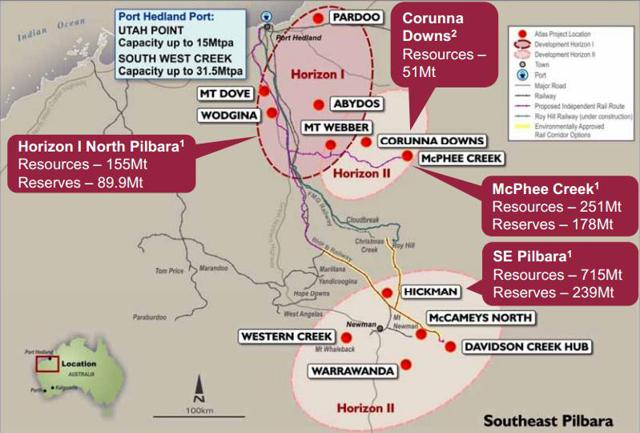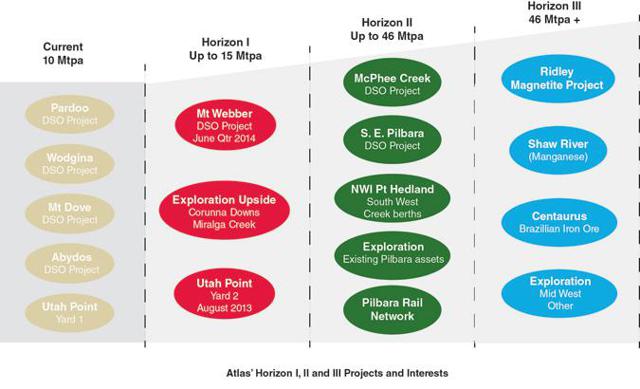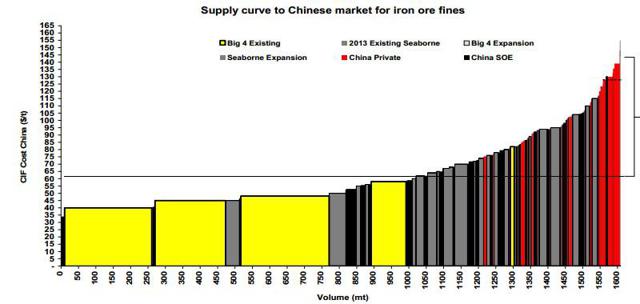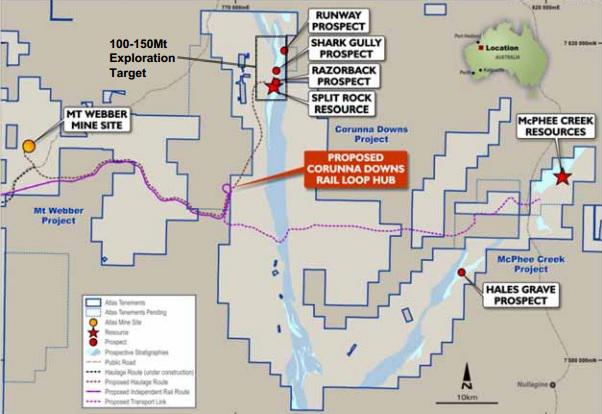Along read but very informative.
http://seekingalpha.com/article/232...omies-of-scale-compensate-for-the-lower-grade
----------------------------------------------
Atlas Iron - Can The Economies Of Scale Compensate For The Lower Grade?
Jul. 20, 2014 1:00 PM ET |
Summary
Introduction
- Atlas Iron suffered from the iron ore price crash, as the discounts for 'lower quality' ore decreased fast.
- However, The company's operating margin should still be approximately 20%, based on the current iron ore price.
- Atlas remains on track to generate a substantial amount of free cash flow, as most of its capital-intensive projects have now been completed.
- The clean balance sheet with a net cash position is quite rare in the sector.
- The fair value seems to be closer to $1/share, which is much higher than the current share price of $0.55 ($505M market cap).
In this article I'll try to determine whether or not Atlas Iron (OTC:ATLGF) could be an interesting investment right now, as the company will reach its sweet spot production rate relatively soon now. Atlas Iron is producing (lower quality) iron ore in Australia, and I will discuss how the price setting of lower quality iron ore works and what the impact is on Atlas Iron's operations and expected profitability.
(click to enlarge)
Source: company presentation
As this is an Australian company, the volume on the US exchanges is quite illiquid, so I'd strongly recommend you to trade in Atlas Iron through the facilities of the Australian Stock Exchange, where the company is listed with AGO as its ticker symbol. There's plenty of volume there with an average dollar volume of in excess of $7M per day. Don't let the penny stock status fool you, at the current share price of $0.55/share, its market capitalization is $505M.
As this is an Australian company, I had to recalculate Australian Dollars into US Dollars where necessary, using an USD/AUD exchange ratio of 1.07. As always, all images in this article were directly taken from the company's website, press releases and presentation.
A quick overview of Atlas Iron's projects
Atlas Iron holds a big portfolio of projects which could be subdivided in three big zones, Horizon I, II and III (even though the company calls the southeast Pilbara zone Horizon II and reserves 'Horizon III' to talk about other investments, I think these projects should be seen as a separate project zone). The company is currently producing and exporting iron ore from its Horizon I zone (see picture), and I expect Atlas to start the studies to determine the economics of the Horizon II zone shortly, as Atlas Iron will have to start thinking about its longer term plans given the fact its mines at Horizon I will be depleted within 10 years.
(click to enlarge)
Source: company website
It's important to emphasize that Atlas Iron is producing 'inferior' iron ore with a lower average grade than the benchmark grade of 62% Fe. This doesn't mean that its product is bad (as it's most definitely saleable) but that it will receive a lower price for its iron ore because of the lower grade (see later in this article). The company is making up for that difference in revenue by trying to benefit from economies of scale. Whereas the company produced just 5.5M wet metric tonnes of iron ore in financial year 2012 (which ends in June), it doubled that production in just two years, as the company recently proudly announced it shipped 10.9M tonnes in Financial Year 2014 and that as it shipped 3.1Mt in the June quarter, the company is currently producing at a rate of in excess of 12 million tonnes per year, thanks to the addition of the Mt Webber project to its portfolio of producing mines.
The recent drop in the iron ore price
The iron ore price has gone down the drain recently and is currently trading at a benchmark price of $98/t. The decline in the iron ore price was fast and really brutal, as the price went down from $120+/t to around $90/t in about two months' time. Needless to say a lot of the iron ore miners saw their operating margins crumble, and that's not different for Atlas Iron (see later).
So what was the main reason for the price drop? First of all, several (mainly Australian) iron ore companies (BHP Billiton, Fortescue,…) were increasing the output of their mines even further, causing an oversupply problem on the market. Additionally, the iron ore inventories at the Chinese ports were reaching very high levels again (up 60% from the level a year ago). This resulted in a decrease in demand for additional iron ore and caused the prices to plummet. However, there's also some good news, as the low iron ore price has caused some Chinese mines with a higher cost structure to shut down (see the next image).
(click to enlarge)
Source: company presentation
How good is the quality of Atlas Iron's ore and what is impacting its received price?
Let's start with the beginning. The iron ore price is based on a benchmark which is an end-product with an iron content of 62% Fe. As you can imagine, products with a higher iron percentage will command a premium price whilst the lower grade ore will be subject to some grade-penalties. This grade discount usually is between $2-3 per percent less than 62% Fe, but after the recent crash in the iron ore price, these discounts have increased. At this moment, the received price for 58%Fe iron ore is approximately $16/t lower which works out to be a discount of $4 per percent. This is obviously a big handicap for Atlas Iron which is indeed producing iron ore with an average grade of 54-57%. So whilst the benchmark price has reached a two month high at $98/t, I expect Atlas received an average price of just $80 per dry metric tonne.
That brings us to a next issue. The received price is calculated per dry metric tonne, but Atlas Iron's iron ore has (just like all other iron ore) a certain moisture content, for which another correcting factor needs to be applied. In Atlas' case I will assume a moisture content of 7% (which is the higher end of the guidance of 6-7%), reducing the sales price by the same percentage to $74/t for Atlas' end product. This is approximately 25% lower than the benchmark price which is based on iron ore with an iron content of 62%, and I think these assumptions are very reasonable.
A third factor is the shipping cost. The benchmark price is based on deliver to a Chinese port, whereby the seller takes care of the transportation costs. Fortunately the shipping cost from West Australia to China has come down a bit to just $7.6/t. If I assume an $8/t shipping cost is being deducted from the revenue, Atlas Iron receives a net price of $66/t for its iron ore. This sounds quite low - as it's a discount of 32% compared to the benchmark price.
However, as Atlas' guidance provides an expected C1 Production cost of $46-49/t, there's a very decent operating margin. If you'd throw in some royalty and exploration expenses and use a total cost of $53/t, Atlas Iron's operating margin is still $13/t, or almost 20%, which isn't bad at all. Given the fact that the production is still ramping up towards a steady state of 14-15M tpa, Atlas Iron could very easily generate a few hundreds of millions of dollars in operating cash flow.
What's the value of the company?
Let's now try to calculate the value of the entire company based on the facts we already know. I will assume an operating margin of $13/t and an output of 13M tpa in the first year, increasing to 14Mtpa in the subsequent 9 years based on the current resource base of the North Pilbara operations. The company has some expansion plans on the table, but I will explain these later in a different calculation.
As the operations are already in production and as Australia is a very safe mining destination, I think a discount rate of 5% is sufficient here. The corporate tax rate in Australia is 30%, so the calculation of the NPV of the currently producing North Pilbara assets should be quite easy. Keep in mind this is a relatively conservative calculation based on the current iron ore price and a strict tax expense, even though the company's effective tax bill might be a tad lower because of carried over losses. However, its tax rate was approximately 30% in the first half of the financial year, and I will keep that tax rate constant, just to be on the safe side. The sustaining capex is $15M per year.
Based on these assumptions, Atlas' Horizon I zone is worth $863M, which is very decent.
Column 1 Column 2 Column 3 Column 4 Column 5 0 Cash Flow Corporate Tax Rate (30%) After-tax cash flow Discount rate (6%) NPV 6% 1 - - - 2 145,000,000.00 30.0% 101,500,000.00 1.00 101,500,000.00 3 160,000,000.00 30.0% 112,000,000.00 1.06 105,660,377.36 4 160,000,000.00 30.0% 112,000,000.00 1.12 99,679,601.28 5 160,000,000.00 30.0% 112,000,000.00 1.19 94,037,359.70 6 160,000,000.00 30.0% 112,000,000.00 1.26 88,714,490.28 7 160,000,000.00 30.0% 112,000,000.00 1.34 83,692,915.36 8 160,000,000.00 30.0% 112,000,000.00 1.42 78,955,580.53 9 160,000,000.00 30.0% 112,000,000.00 1.50 74,486,396.73 10 160,000,000.00 30.0% 112,000,000.00 1.59 70,270,185.59 11 160,000,000.00 30.0% 112,000,000.00 1.69 66,292,627.92 12 863,289,534.74
Unfortunately the mine life is limited to 'just' 10 years, and Atlas Iron will have to make work of the development of its Corunna and McPhee Creek deposits (see next image for the location) which are situated a bit to the southeast of the currently producing assets. However, I expect the capital expenditures to be relatively high, as Atlas Iron would have to construct a railway to be able to transport the ore to the port. Railways aren't exactly cheap, so I the total development cost of McPhee/Corunna could very well be close to $6-700M, as approximately 80 miles (conservatively seen) of rail spur will have to be constructed.
Source: company presentation
However, it would be worth it, as both projects have a total resource of 300 million tonnes of iron ore. The grade will be a bit lower though and I'm estimating the average grade will be 56% Fe, which would reduce the operating margin to $10/t. Let's see what the fair value of the Corunna/McPhee Creek plans would be, using a 14 year mine life. I will use a higher discount rate of 8% as this project obviously isn't in production yet.
So at the current low iron ore price, the expansion to Corunna Downs and McPhee Creek would have a value of $296M. Keep in mind this NPV might change drastically depending on the initial capital expenditures. If the initial capex would be just $500M as compared to the used $700M, the NPV would increase to close to $500M. Additionally, a change of $4/t in the received iron ore price will have an impact of $350M on the after-tax NPV8%. So the expansion towards the Corunna and McPhee Creek projects will be highly levered to the iron ore price.
Column 1 Column 2 Column 3 Column 4 Column 5 0 Cash Flow Corporate Tax Rate (30%) After-tax cash flow Discount rate (8%) NPV 8% 1 -700,000,000.00 - -700,000,000.00 -700,000,000.00 2 130,000,000.00 0.0% 130,000,000.00 1.00 130,000,000.00 3 125,000,000.00 0.0% 125,000,000.00 1.08 115,740,740.74 4 125,000,000.00 0.0% 125,000,000.00 1.17 107,167,352.54 5 125,000,000.00 0.0% 125,000,000.00 1.26 99,229,030.13 6 125,000,000.00 0.0% 125,000,000.00 1.36 91,878,731.60 7 125,000,000.00 0.0% 125,000,000.00 1.47 85,072,899.63 8 125,000,000.00 0.0% 125,000,000.00 1.59 78,771,203.36 9 125,000,000.00 28.0% 90,000,000.00 1.71 52,514,135.57 10 125,000,000.00 30.0% 87,500,000.00 1.85 47,273,527.39 11 125,000,000.00 30.0% 87,500,000.00 2.00 43,771,784.62 12 125,000,000.00 30.0% 87,500,000.00 2.16 40,529,430.21 13 125,000,000.00 30.0% 87,500,000.00 2.33 37,527,250.19 14 125,000,000.00 30.0% 87,500,000.00 2.52 34,747,453.88 15 125,000,000.00 30.0% 87,500,000.00 2.72 32,173,568.41 16 296,397,108.28
That being said, the company doesn't really have a choice, as the Horizon I mines will be empty in 10 years from now. So the Corunna/McPhee expansion will have to happen, and the question will be at what price Atlas Iron will be able to realize the projects. At this point I'd use a ratio of 0.15 times the NPV for Corunna/McPhee, resulting in a current value of $45M.
Now I'd have to subtract the net debt position of Atlas Iron, but the good news is that there's actually a net cash position (after H1 FY 2014). This net cash position was minimal, and because some more capital expenditures had to be funded in H2, I will use a neutral net debt/cash position at this point in time.
Investment thesis
The iron ore sector really got hurt lately, and Atlas Iron's share price is a perfect example to see the impact of a crashing iron ore price on a company's share price. Whereas the company was trading at $1 just three months ago, the share price has decreased by a stunning 45% to the current level of $0.55/share.
Was this drop fair? Yes, I think so, as Atlas Iron ore is producing a product of a lower quality than the benchmark product, and as such its realized sales price is lower, resulting in more pressure on its operating margins. However, even at the current iron ore price, I expect Atlas Iron to have an operating margin of approximately 20%, and the company should generate a lot of free cash flow from here on as its main capital expenditures have already been incurred. I expect the capex to drop after spending more than half a billion in just the past two years.
If I apply a sum of the parts valuation - and ignore the Horizon III projects which are located the furthest away from Port Hedland- I end up with a total value of $910M, based on the current iron ore price and freight prices from Australia to China. This is considerably higher than the current market capitalization of $504M, and even though the company is producing an 'inferior' end product, I'm not sure a discount of 45% to the NPV is warranted. Additionally, the dividend will be extremely safe as it would definitely be covered by the free cash flow as the capex is expected to drop substantially.
However, investors should be cautious, as Atlas Iron's operating margin currently is 'just '$13/t, and a further contraction of this margin could have a serious impact on the value of its assets. However, after talking to some people in the sector, most seem to think the discount for lower quality iron ore will actually decrease, which should provide additional upside potential for Atlas Iron.
I currently have no position in Atlas Iron, but could initiate a speculative position at any time.
Editor's Note: This article covers a stock trading at less than $1 per share and/or with less than a $100 million market cap. Please be aware of the risks associated with these stocks
Add to My Watchlist
What is My Watchlist?








